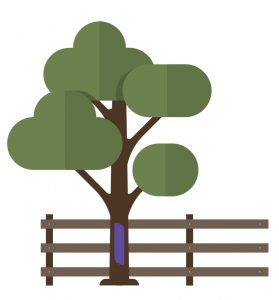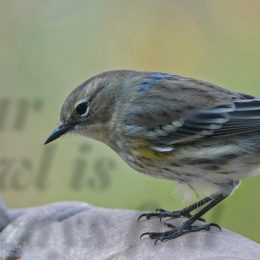
IC 35-43-2-2 says the “purple mark” on a tree must be: • a vertical line at least 8 inches in length with the bottom of the mark at least 3 feet and not more than 5 feet from the ground; • not more than 100 feet from the nearest other marked tree. On a post, the mark must: • cover at least the top 2 inches of the post; • be at least 3 feet and not more than 5 feet, 6 inches from the ground • be not more than 36 feet from the nearest other marked post.
When I first heard about the new “Purple Paint No Trespass” law, I thought it was a joke. But believe it or not, in our label-loving, litigious society, an easy-to-read “No Trespassing” sign is being upstaged by a simple swatch of purple paint strategically placed on a post or tree. This can now legally define areas of denied entry as well.
I couldn’t help in my twisted humor but wonder if the sign manufacturers had been out-lobbied by the paint manufacturers. I even checked the local farm supply store, and it had a good supply of “No Trespassing” signs. Some locations even sell the signs in Spanish.
We are a nation that demands we be told of eminent danger or of situations of unintentional rule breaking. Everywhere we see signs saying: “Don’t Feed The Animals,” “Don’t Walk On The Grass,” “Coffee is Hot,” etc.
I can see where the new legislation may create havoc for Hoosier woodland wanderers and our Indiana conservation officers. The legislation brings up more than a few questions!
First, how is the general public supposed to learn of the new ruling? I know there are a few people who read this column but come on, where is the media blitz to notify the masses? Do we need to post signs telling misguided woodland wanderers the purple swatches replaced the signs telling people to stay out?
And secondly, how can an enforcement officer be sure the swatch of paint was simply not seen by an unaware trespassing offender?
I also question the selection of the color purple. In shadows or dim light, purple paint can be hard to detect. Why wasn’t the law written around using “blaze orange” paint or “high visibility green?” Should the paint also be luminous so it will glow in the dark to notify nighttime woodland walkers, raccoon hunters and the like?
One place where purple paint on trees and posts designates something forbidden is in Haiti. When traveling the roads and you see purple painted trees and posts and utility poles, it signifies it is where the local voodoo witch doctor lives. For me, this application is a “big time” no trespassing indicator.
The official media release for our Hoosier residents reads:
“Hunters, anglers, trappers and anyone else who enjoys time in the woods will need to be aware of a new law that took effect July 1. Per Indiana Code (IC 35-43-2-2), landowners may mark no-trespassing areas of their property with purple paint instead of no-trespassing signs.
“The purple-paint perimeter serves the same legal purpose as a “No Trespassing” sign. Painting can be done around the perimeter of the area where entry is denied on either trees or posts.
“The purple marks must be readily visible to any person approaching the property.”
My good friend Paul Coffey from Shelby County heard about the new law and wanted to paint trespass boundaries on his new property. Sure enough, he found the local farm supply stores completely sold out of “no trespassing” exterior purple.
For more information, see IC 35-43-2-2 at iga.IN.gov.
Jack Spaulding is a state outdoors writer and a consumer of RushShelby Energy living along the Flatrock River in Moscow. Readers with questions or comments can write to him in care of Electric Consumer, P.O. Box 24517, Indianapolis, IN 46224; or email jackspaulding@hughes.net.



